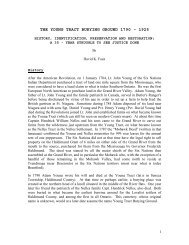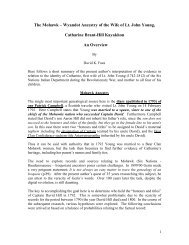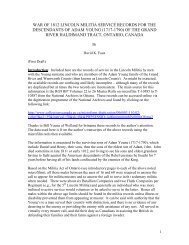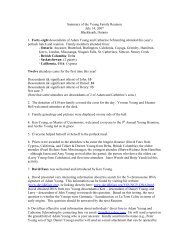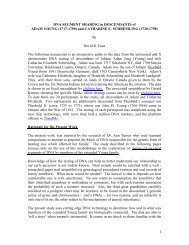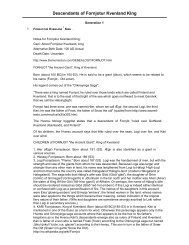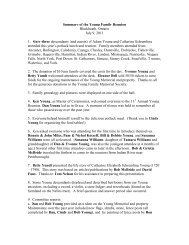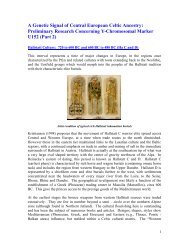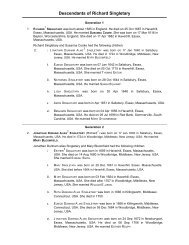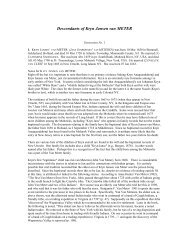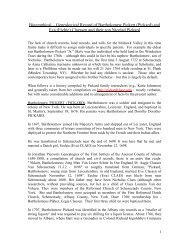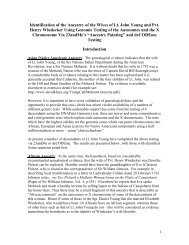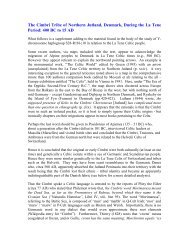Mohawk â Wyandot Ancestry of Lt. John Young's ... - Davidkfaux.org
Mohawk â Wyandot Ancestry of Lt. John Young's ... - Davidkfaux.org
Mohawk â Wyandot Ancestry of Lt. John Young's ... - Davidkfaux.org
- No tags were found...
You also want an ePaper? Increase the reach of your titles
YUMPU automatically turns print PDFs into web optimized ePapers that Google loves.
compelling reason to assume that Martin’s version is more likely correct relative toinformation provided by Nelles family members. The present author does not recall thename Tahatonne or Tahanata appearing in any record pertaining to the <strong>Mohawk</strong>s <strong>of</strong> theGrand River (1787 – 1896) other than the 1815 list and the Nelles obituary respectively –or if so it is not easily recognizable. As we shall see, the evidence strongly suggests thatthese are entirely different names with entirely different meanings – the surfacesimilarities being an illusion.An examples <strong>of</strong> a possible earlier instance <strong>of</strong> the name Tahatonne is found on 5 April1687 a <strong>Mohawk</strong> named Tahaiadons <strong>of</strong>fered proposals at a conference in Albany – thismay be the same sachem, so TA-HA-IA-DONS. With reference to Tahanata, on theabove 1789 deed signed by the Canajoharie <strong>Mohawk</strong>s there is a name, DavidDehanonyantha. His identity is unknown. Phonetically this is similar to, and perhapsmore precisely written, Tahanata (D and T being equivalent in <strong>Mohawk</strong>). It isexceedingly difficult even for those who are fluent in the language to determine whethertwo <strong>Mohawk</strong> names are identical, due to spelling and dialectical differences and changein word meaning over time. One other example <strong>of</strong> a Six Nations name likely to beequivalent to Tahanata was “Tachanuntie or Tachanontia”, an Onondaga Chief attendingthe June 1744 Conference in Lancaster, Pennsylvania. He was known as “the BlackPrince” due to his African – Indian heritage, although others say it was due to his tatoos(Colden, 1747, p.110; Shannon, 2008).There is also the strong possibility that names introgressed from other Iroquoian Nations(more on this subject later), especially after the wars <strong>of</strong> the mid 17 th Century whenIroquoian speaking tribes such as the Huron, Wenro, Attiwandaronk, and Erie wereeffectively destroyed, and many <strong>of</strong> the survivors adopted into member nations <strong>of</strong> theIroquois Confederacy.Clearly Tahanata is a Six Nations name (Iroquoian language family) with some antiquity.For example on 12 July 1742 among the Tuscaroras at a conference in Philadephia wasTahnatakqua. Reg Henry (see below) told the present author that frequently endings suchas “ha” to personal names are dropped in everyday use. An example relating to the<strong>Mohawk</strong>s is Brant Canagaradunckwa (various spellings). On 23 August 1752 Brantappended a note written in <strong>Mohawk</strong> to Conrad Weiser in a letter sent by Daniel Claus.He signed his name “Kanakaradon” in this document (Kelsay, 1986). He dropped the“ckwa” which is equivalent to the “kqua” in the name above. Among the <strong>Mohawk</strong>s <strong>of</strong>the Bear Tribe from Canajoharie, accompanying Sir William <strong>John</strong>son to Montreal in1760, was Johannes Tehanagrackhas. Here the “ckhas” could have been “optional” so ifdropped yielding Tehanaghra. If the last “r” was meant to be a “t” this name would beidentical to Tahanata - maybe.In truth, there is no clear evidence that either name has appeared in the historical recordamong the <strong>Mohawk</strong> prior to their appearance as the names <strong>of</strong> Cotter and Nellesrespectively.32



